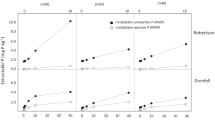Summary
A bis-(p-nitrophenyl) phosphatase (BPN-Pase) was extracted from a forest soil and fractionated by DEAE-cellulose column chromatography into seven fractions (1, 2, 3, 4, 5, 6 and 7). The main fraction (fraction 5) was further fractionated into 3 subfraction (fractions 1, 2 and 3) by affinity chromatography for nuclease. The properties of the BPNPase in subfraction 3 were characterized and the results are reported in this article. Subfraction 3, which had a peak at about 278 run in the UV absorption spectrum, hydrolyzed 2′,3′-cyclic-nucleotides more readily than 3′,5′-cyclicnucleotides, adenylyl-(3′ → 5′)uridine, uridylyl-(3′ → 5′)adenosine, thymidine 3′-p-nitrophenyl phosphate, thymidine 5′-p-nitrophenyl phosphate, p-nitrophenyl phosphate and BPNP. Subfraction 3 hydrolyzed BPNP into 2 mol p-nitrophenyl and 1 mol inorganic phosphate during incubation. Apparent molecular weight of the BPNPase was estimated to be about 58 000 by gel filtration. The BPNPase activity had a pH optimum at 5.0 and was inhibited by Hg2+ and slightly inhibited by F− and PO 3−4 .
These observations suggest that the BPNPase is subfraction 3 has been constituted mainly with 2′,3′cyclic-nucleotide 2′-phosphodiesterase [EC 3.1.4.16] or 2′,3′-cyclic-nucleotide 3′-phosphodiesterase [EC 3.1.4.37].
Similar content being viewed by others
References
Anraku Y (1964) A new cyclic phosphodiesterase having a 3′-nucleotidase activity from Escherichia coli B. J Biol Chem 239; 3412–3419
Andrew P (1965) The gel-filtration of proteins related to their molecular weights over a wide range. Biochem J 96; 595–606
Bernardi A, Bernardi G (1971) Spleen acid nuclease. In: Boyer PD (ed) The enzymes, 3rd edn, vol 4. Academic Press, New York, London, pp 329–336
Beernardi G, Appella E, Zito R (1965) Studies on acid deoxyribonuclease. III. Physical and chemical properties of hog spleen acid deoxyribonuclease. Biochem 4:1725–1729
Eivazi F, Tabatabai MA (1977) Phosphodiesterases in soils. Soil Biol Biochem 9:167–172
Frischaut AM, Eckstein F (1973) Purification of a phosphodiesterase from Bothrops atrox venom by affinity chromatography. Eur J Biochem 32:479–485
Hayano K (1977) Extraction and properties of phosphodiesterase from a forest soil. Soil Biol Biochem 9:221–223
Hayano K (1983) Fractionation by DEAE-cellulose column chromatography and some properties of phosphodiesterase extracted from an Andosol under forest. Soil Sci Plant Nutr 29:175–184
Ishii T, Hayano K (1974) A method for the estimation of phosphodiesterase activity in soil. Jpn J Soil Sci Plant Nutr 45:505–508
Kakii K, Yoshida H (1977) Phosphodiesterase-phosphomonoesterases from Fusarium moniliforme. A method of purification and identification of isozymes. J Biochem 81:1691–1697
Khorana HG (1961) Phosphodiesterases. In: Boyer PD, Lardy H, Myrback K (eds). The enzymes, 2nd edn, vol 5. Academic Press, New York,London pp 79–94
Laskowski M (1971) Venom exonuclease. In: Boyer PD (ed) The enzymes, 3rd edn, vol. 4. Academic Press, New York, London, pp 313–328
Neu HC (1968) The cyclic phosphodiesterase of the Enterobacteriaceae. Biochem 7:3774–3780
Razzell WE (1963) Phosphodiesterases. In: Method in enzymology, vol. 6. Colowick SP, Caplan NO (ed) Academic Press, New York, London, pp 236–258
Shimada K, Sugino Y (1969) Cyclic phosphodiesterase having 3′-nucleotidase activity from Bacillus subtilis. Purification and some properties of the enzyme. Biochim Biophys Acta 185:367–380
Taussky HH, Shorr E (1952) A microcolorimetric method for the determination of inorganic phosphorus. J Biol Chem 202:675–685
Uchida T, Egami F (1971) Microbial ribonucleases with special reference to RNases T1, T2, N1 and U2. In: Boyer PD (ed). The enzymes, 3rd edn, vol. 4. Academic Press, New York, London, pp 205–250
Unemoto T, Hayashi M (1969) Chloride ion as a modifier of 2′, 3′-cyclic phosphodiesterase purified from halophilic Vibrio alginolyticus. Biochim Biophys Acta 171:89–102
Yoshida H (1973) Acid phosphatases from Fusarium moniliforme. III. Mode of action of acid phosphatase II on bis-(pnitrophenyl)phosphate. J Biochem 73:23–29
Author information
Authors and Affiliations
Rights and permissions
About this article
Cite this article
Hayano, K. Characterization of a phosphodiesterase component in a forest soil extract. Biol Fert Soils 3, 159–164 (1987). https://doi.org/10.1007/BF00255777
Received:
Issue Date:
DOI: https://doi.org/10.1007/BF00255777




